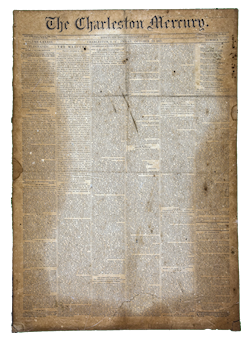April 13, 1861; The Charleston Mercury
We stated yesterday that on Thursday, at three o’clock, p.m. General BEAUREGARD had made a demand upon Major ANDERSON for the evacuation of Fort Sumter through his Aids, Colonel CHESNUT, Captain LEE, and Colonel CHISHOLM, and that Major ANDERSON had regretfully declined, under the circumstances of his position. It was, however, understood that unless reinforced he would necessarily yield the post in a few days–say by the fifteenth. An effort was, therefore, made to avoid an engagement, without incurring greater risk of reinforcement. At one and a half, a.m., Colonel CHESNUT and Captain LEE reached Fort Sumter from General BEAUREGARD, and, we gather, were prepared to enter into any arrangement for non action as to Fort Sumter, if no assistance were given to the efforts of reinforcement; but postponement merely to mature hostile plans was impossible. No satisfactory agreement being proposed, and time being important, at three and a half o’ a.m., Major ANDERSON was notified that, at the expiration of an hour, the batteries would open their fire upon him. The Aids then passed thence in a boat to Fort Johnson, and Col. CHESNUT ordered the fire to begin. Precisely at four and a half o’ a shell was fired from the signal battery on James’ Island, which, making a beautiful curve, burst immediately above Fort Sumter. Within fifteen minutes all the Carolina batteries were in full play. The inhabitants of Charleston forthwith thronged to the East Bay Battery and other points of observation, and excitement prevailed through the day amid various and stirring rumors put afloat from time to time. Major ANDERSON, no oil to light up his casemates, and the morning being slightly murky and drizzly, did not respond until broad day. At a quarter before six he opened his fire by a shot at the Iron Battery on Cumming’s point; then at Fort Moultrie, the Floating Battery, located at the west end of Sullivan’s Island; the Dahlgreen Battery, the Enfilade Battery, Major TRAPIER’s Battery, and Fort Johnson, interspersing his attentions by paying respects to the numerous mortar batteries, by which he, encased in brick, is surrounded. Hour after hour has the fire on both sides been kept up, deliberate and unflagging. The steady frequent shock of the cannon’s boom, accompanied by the hiss of balls, and the horrid, hurtling sound of the flying shell, are now perfectly familiar to the people of Charleston. While the early sun was veiled in mist, we saw shell bursting within and illuminating Fort Sumter, or exploding in the air above, leaving a small thick cloud of white smoke to mark the place. We saw solid shot striking the dark walls, and in each instance followed by a fume of dust from the battered surface. One man was visibly stricken prostrate on the wharf, and carried in the fort; and several guns were dismounted. The walls, too, in several spots, were damaged. And while Sumter has certainly and manifestly been injured, no loss is yet sustained on our part. Fort Moultrie is intact, so far as fighting capacity is concerned. The Iron Battery is ready for continued work, after a full and fair trial of its powers of resistance; also the Floating Battery. The practice of our soldiers, as marksmen, has been excellent and highly satisfactory to officers of science and experience; and, great gratification, at the last accounts, six o’, p.m., not one man of our army has suffered injury.
The Pawnee and Harriet Lane are lying off North Channel bar, with another ship, supposed to be the Baltic; at ship bar, a war ship, judged to be the Illinois. Whether they will attempt to reinforce Fort Sumter in barges tonight, or land troops on Morris Island for an engagement, or will try to run the gauntlet of our channel batteries and Fort Moultrie, remains to be seen, and we will see.
